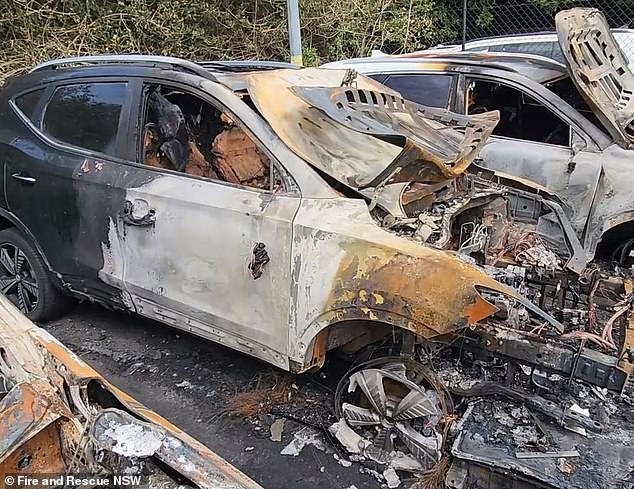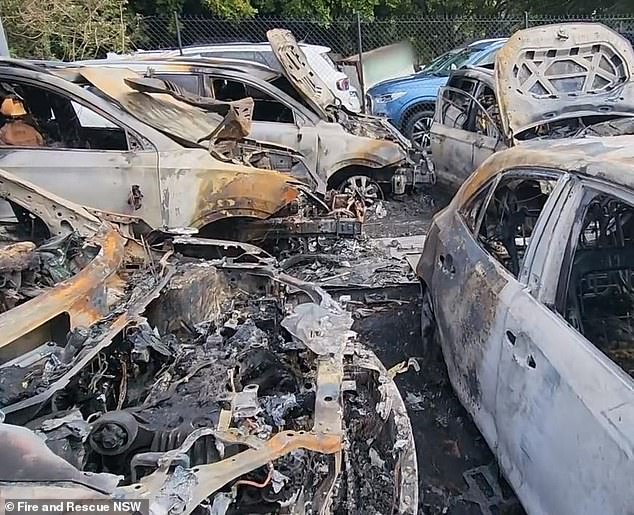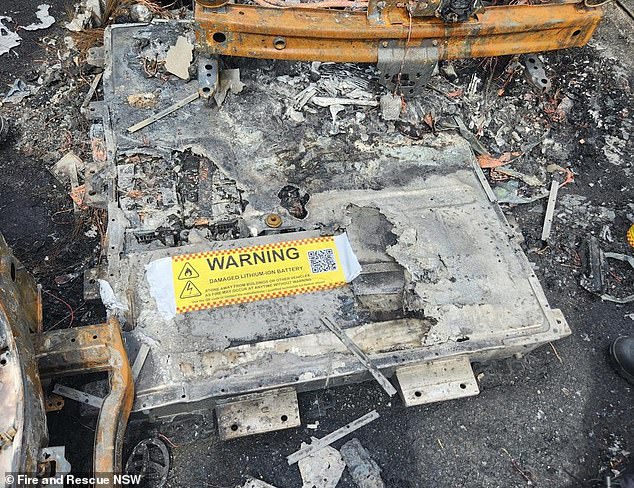Electric vehicle fires: The little-known but terrifying reality about EV batteries – after one from an MG caused a blaze that destroyed five cars and a Tesla burst into flames
EXCLUSIVE
The number of fires caused by lithium-ion batteries found in popular items such as e-bikes, e-scooters and electric vehicles is increasing – with two cars catching fire on the same day this week.
And a well-placed source said fire departments across Australia were “very concerned” that they would continue to increase as the use of lithium-ion batteries rises.
“What we do know is that there will be more fires,” the source said, noting that the fumes from a battery fire were much more toxic than those from a standard fire.
Firefighters were called to a Sydney Airport car park on Monday to discover five cars had become burnt-out wrecks.
The lithium battery, which was detached from an MG ZS EV, was identified as the cause of the fire in the Airport Drive car park in Mascot.
Meanwhile, on the same evening in Penrose, in the Southern Highlands of NSW, a Tesla Model 3 caught fire after being struck by the tail axle of a truck in front.
Firefighters from the Penrose Rural Fire Brigade fortunately managed to extinguish the fire.
The driver and passenger inside were able to stop and get out of the car before it caught fire. The fire brigade extinguished the fire in just over half an hour.
NSW Fire and Rescue Superintendent Adam Dewberry said 165 fires linked to lithium-ion batteries were reported in the state last year.
From the beginning of this year to the end of July, that number is 114.
“We’re seeing some of these lithium-ion related fires, there’s no doubt about that,” he told Daily Mail Australia.
‘That is why we have started a joint research program into it.’
However, the source said the actual number would be “double” in NSW alone.
The source said the problem is that technological advances have outpaced regulations and laws. Multi-story parking garages are built to withstand fires started by conventional vehicles, not fires started by “a thermal event caused by a faulty battery.”
Fire and Rescue NSW has launched a joint research program known as the Safety of Alternative and Renewable Energy Technologies (SARET).
With the help of other fire services, government agencies and research institutions, the program will look at the best responses to fires related to lithium-ion batteries and EV-related fires.
Mr Dewberry said both EV-related fires on Monday were caused by external factors.
“The battery in the car under the airport was already damaged and had been removed, and the one in Penrose had landed on some rubble,” he told Daily Mail Australia.
‘We are monitoring the entire situation and so far things are going well and electric cars are largely safe. But there are still things we continue to investigate.”
Mr Dewberry said it was difficult to say whether a non-electric car would have caught fire after being hit by debris, similar to the electric car hit in Penrose.
“It’s certainly possible,” he said.
“We have seen non-electric vehicles catch fire after collisions. The SARET program is about ensuring they stay ahead and identifying any risks.”
Dr. Matthew Priestley, who has a PhD in electrical engineering from the University of New South Wales, said the most important thing EV drivers should pay attention to is not overheating the battery.
Thermal runaway, as it is known, is when the battery overheats uncontrollably and cannot cool down.
Firefighters extinguish a fire in a Tesla after its battery overheated in Penrose, NSW

Five cars were found burnt out in the Sydney Airport car park after a lithium-ion battery caught fire
‘It’s like a snowball going down a hill. The main thing is you never want to let the battery get past that temperature,” Priestley told Daily Mail Australia.
“Once you get above that temperature, even if you put it out, the fire can still reignite hours and even days later if you haven’t cooled it down.”
Dr. Priestley said another problem with the batteries is that when they are on fire, they emit toxins “that you don’t want to breathe.”
“Getting close to the battery is not only a fire risk, it is also a toxic risk,” he said.
He said electric vehicles have very high-end production when it comes to lithium batteries.
Teslas, for example, have battery management systems that inform the driver when there is a problem with the battery.
Dr. Priestley said treating a car, especially an electric vehicle, with the utmost respect is the key to safety.
He said EV owners should have the battery inspected after a serious collision, as a collision can often involve mechanical damage, which can lead to overheating.
He also advised owners never to buy second-hand batteries or do any work on their EV themselves.

A fire that started in the lithium-ion battery of an electric vehicle has burned out five cars at Sydney Airport
“These cars are safe, treat them with respect and if you suspect there is a problem, contact your car manufacturer,” he said.
‘Don’t try to put out the fire yourself because you may think you are putting it out, but in reality you are just breathing in toxic fumes.’
Emma Sutcliffe, project director at EV Fire Safe, which provides free electric vehicle fire safety knowledge to emergency services, said there were often warning signs that an EV battery had overheated.
“There are loud noises like gunshots and popping noises,” she said.
‘There are also whistling sounds, which are the gases escaping from the battery.’
She said that while EV batteries can sustain a lot of damage before catching fire, the biggest concern was the lithium-ion batteries in smaller devices.
“As far as we are concerned, it concerns e-bikes and e-scooters, because they have a much poorer quality battery,” she said.

The fire was traced to a battery that had been removed from the vehicle and stored on the property
Monday’s incidents were the only two EV-related fires in NSW this year.
Fires involving other electric motor equipment, such as scooters and bicycles, are much more common.
In June, the garage of a home in Bass Hill in Sydney’s south-west burst into flames after a man accidentally charged a faulty battery for his e-bike, which he had bought from a friend.
On the same day, in Orange, central west NSW, another fire broke out in a garage after a lithium battery a man had been using to charge his drone exploded.
The man had to run his daughter out of the house and use a garden hose to put out the fire.
FRNSW Acting Assistant Commissioner Trent Curtin said residents were fortunate in both cases not to have been seriously injured or killed.
“Lithium-Ion batteries, when defective or damaged, can overheat and have the potential to explode violently, resulting in fires that can flare up again after extinguishing and sometimes take days to burn,” said Acting Deputy Commissioner Curtin at the time.
‘Always stick to reputable battery brands, make sure they are compliant and don’t mix up components.
‘Do not leave lithium-ion batteries continuously charging, do not sleep while charging, and unplug the power cord when leaving home.’
Mr Curtin said the fire service was averaging one lithium-ion fire per week.
“I’m afraid someone will die if he or she doesn’t follow the safety advice,” he said.
